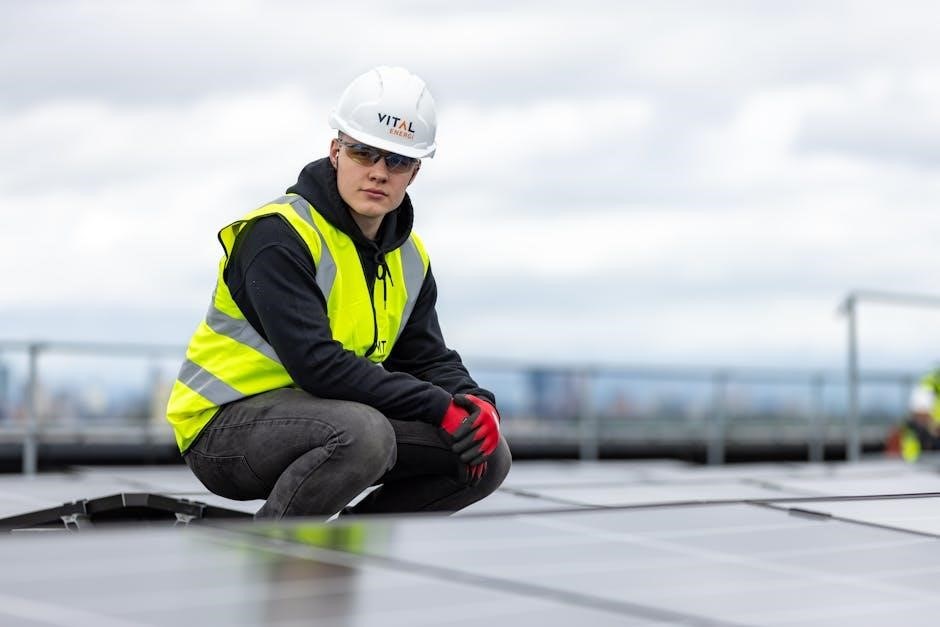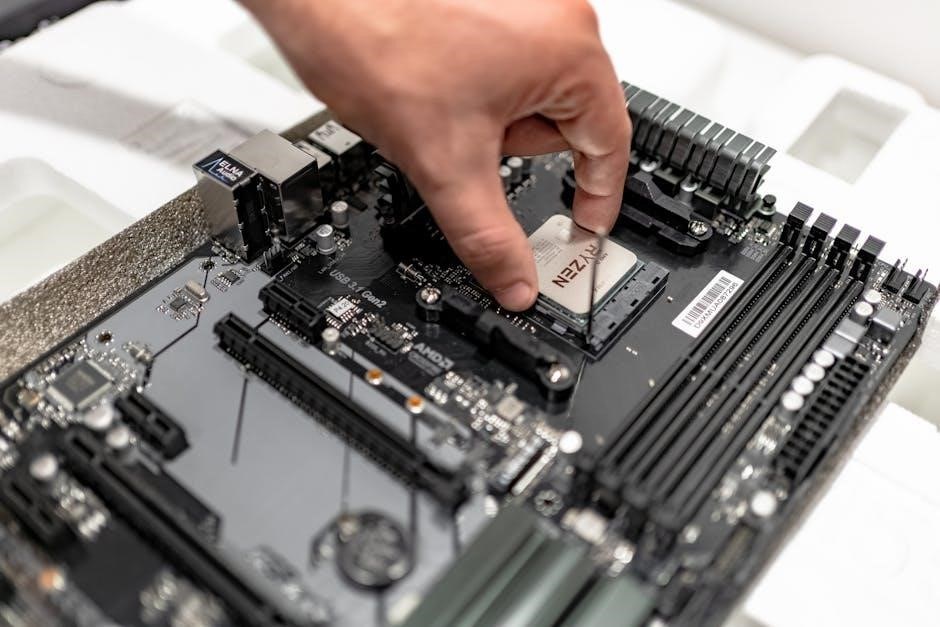
The EG4 12kPV Hybrid Inverter is a high-efficiency, versatile energy solution designed for seamless integration of solar, battery, and grid power. It supports residential and commercial applications, ensuring reliable energy management and optimization. With advanced monitoring capabilities and user-friendly interfaces, it simplifies energy control and maximizes system performance. Compliance with international standards ensures safety and durability, making it a preferred choice for modern energy systems.
1.1 Overview of the EG4 12kPV Hybrid Inverter
The EG4 12kPV Hybrid Inverter is a high-efficiency, versatile energy management solution designed for residential and commercial applications. It seamlessly integrates solar, battery, and grid power, providing a reliable and comprehensive energy system. The inverter supports advanced monitoring and control, enabling real-time tracking of energy production, storage, and consumption. With built-in safety features and compliance with international standards, it ensures secure and durable operation. Suitable for both on-grid and off-grid configurations, the EG4 12kPV is ideal for users seeking energy independence and optimized performance. Its compact design and user-friendly interface make it a popular choice for modern energy systems.
1.2 Key Features and Benefits
The EG4 12kPV Hybrid Inverter offers high efficiency and seamless integration of solar, battery, and grid power, making it a versatile energy solution. It supports advanced monitoring and real-time data tracking, enabling optimal energy management. The inverter is designed for both on-grid and off-grid systems, providing flexibility and reliability. Key features include high-efficiency power conversion, built-in safety protections, and compatibility with various battery types. Benefits include reduced energy costs, enhanced system durability, and user-friendly control interfaces. Its hybrid functionality ensures uninterrupted power supply during grid outages. The EG4 12kPV is ideal for residential and commercial applications, offering a robust and scalable energy management system.

Pre-Installation Checks
Ensure EG4 12kPV compatibility with existing systems, assess site conditions, verify regulatory compliance, and confirm all components are in good condition and readily available before installation.
2.1 System Compatibility and Requirements
Ensure the EG4 12kPV is compatible with your solar panels, battery, and grid connection. Verify the system’s power rating and voltage range match your setup. Check for compatibility with MPPT solar chargers and communication protocols like CAN or RS485. Confirm the inverter’s efficiency and operating temperature range suit your climate. Ensure all components meet local electrical standards and regulations. Review the installation manual for specific wiring and configuration requirements. Verify the availability of necessary tools and materials before proceeding. Ensure the system is designed for your energy needs, whether residential or commercial. Proper compatibility ensures safe, efficient, and reliable operation of the EG4 12kPV inverter.
2.2 Site Assessment and Preparation
Conduct a thorough site assessment to ensure the location is suitable for the EG4 12kPV inverter installation. Verify the area is well-ventilated, accessible, and protected from direct sunlight to prevent overheating. Ensure the site is free from flammable materials and meets local fire safety codes. Check for proper grounding and surge protection to safeguard against electrical hazards. Assess the proximity to power sources and solar panels for efficient wiring. Clean and dry the installation area to prevent moisture-related issues. Ensure all necessary tools and materials are readily available. Proper site preparation ensures a safe and efficient installation process for the EG4 12kPV inverter.

Safety Precautions
Always follow local wiring standards, regulations, and installation instructions. Use recommended tools and ensure proper torque for connections. Keep the area free from flammable materials and ensure proper grounding and surge protection to prevent electrical hazards. Adhere to all safety guidelines to safeguard personnel and equipment during the installation process.
3.1 General Safety Guidelines
Before starting the installation, ensure the system is disconnected from all power sources, including solar panels and batteries. Always wear appropriate Personal Protective Equipment (PPE), such as insulated gloves and safety goggles, when handling electrical components. Follow all local and national electrical codes, regulations, and standards to ensure compliance. Avoid working in wet or humid conditions, as this increases the risk of electrical shock. Properly ground the system to prevent electrical hazards. Use only the recommended tools and materials specified in the installation manual. Regularly inspect components for damage or wear before installation. Ensure proper ventilation in the workspace and keep flammable materials away. Adhere strictly to the manufacturer’s instructions and safety guidelines to safeguard personnel and equipment during the installation process.
3.2 Personal Protective Equipment (PPE)
Always wear appropriate Personal Protective Equipment (PPE) when installing or servicing the EG4 12kPV inverter to minimize risks of injury. Essential PPE includes insulated gloves rated for high voltage, safety goggles, and arc-rated clothing. A hard hat and non-conductive footwear should also be worn in work environments with potential hazards. Ensure all PPE meets relevant safety standards, such as NFPA 70E, for electrical work. Properly inspect PPE before use and replace any damaged or worn-out items. Maintain a safe distance from live electrical components and avoid jewelry that could conduct electricity. Adherence to PPE guidelines is critical for protecting personnel during installation and maintenance tasks.

Installation Steps
The EG4 12kPV installation involves several key steps: mounting the inverter, connecting solar panels, integrating the battery, and wiring the grid connection. Proper planning ensures efficiency and safety;
4.1 Mounting the Inverter
Mounting the EG4 12kPV Inverter requires careful planning to ensure stability and optimal performance. Choose a location with good ventilation, accessibility, and protection from direct sunlight or moisture. Use the provided mounting brackets to secure the inverter to a wall or floor, ensuring it is level and firmly fastened. Follow the torque specifications for bolts to prevent damage. Ensure the area is clear of flammable materials and that the inverter is installed in an upright position. Double-check all connections before powering up. Proper mounting is crucial for safety, efficiency, and compliance with installation guidelines.
4.2 Connecting Solar Panels
Connecting solar panels to the EG4 12kPV Inverter requires precise steps to ensure optimal performance and safety. Begin by connecting the solar panel array to the inverter’s DC input terminals, ensuring correct polarity (positive to positive, negative to negative). Verify the maximum power voltage (Vmp) and short circuit current (Isc) of the panels match the inverter’s specifications. Use compatible connectors and tighten terminals securely. Avoid over-tightening to prevent damage. Ensure the solar array is properly grounded and insulated. Double-check all connections before enabling the system. Follow the recommended wiring diagrams in the manual to avoid configuration errors. Proper solar panel connection is critical for efficient energy generation and system reliability.
4.3 Connecting the Battery
Connecting the battery to the EG4 12kPV Inverter is a critical step that requires careful attention to detail. Ensure the inverter is powered off before starting. Connect the battery cables to the designated DC terminals, matching positive to positive and negative to negative. Tighten the terminals securely to avoid loose connections. Verify the battery voltage and capacity are compatible with the inverter’s specifications. Use appropriately sized cables to minimize resistance and heat. Double-check all connections for correctness before powering on the system. Proper battery connection ensures reliable energy storage and seamless operation of the hybrid power system. Always follow the manual’s wiring diagram for accuracy.
4.4 Grid Connection and Wiring
Grid connection and wiring are essential for integrating the EG4 12kPV Inverter into your electrical system. Ensure the AC output from the inverter matches your grid’s voltage and frequency. Connect the inverter’s AC terminals to the grid using appropriately sized cables, following local wiring standards. Use recommended connectors and ensure all connections are secure with proper torque. Verify the grid connection polarity to avoid system malfunctions. Always disconnect the grid supply before performing any maintenance. Proper wiring ensures safe and efficient energy flow between the inverter and the grid, optimizing overall system performance and reliability. Refer to the manual for specific torque values and wiring diagrams.

Configuration and Setup
The EG4 12kPV configuration and setup enable seamless integration of solar, battery, and grid systems, ensuring efficient energy management and monitoring for optimal performance and reliability.
5.1 Initial Configuration of the EG4 12kPV
Initial configuration of the EG4 12kPV involves setting up the inverter’s basic parameters to ensure proper operation. Begin by updating the firmware to the latest version for optimal performance. Connect the inverter to your solar panels, battery, and grid according to the installation manual. Use the provided software or app to configure settings like charging modes, grid interaction, and backup priorities. Ensure all connections are secure and aligned with local electrical standards. Test the system to verify functionality and adjust settings as needed for efficiency. The user-friendly interface simplifies this process, enabling quick setup and ensuring reliable energy management.
5.2 Network Configuration for Monitoring
Configure the EG4 12kPV’s network settings to enable remote monitoring and real-time data access. Connect the inverter to your local network using Ethernet or Wi-Fi for seamless communication. Use the provided monitoring software or app to set up a secure connection. Ensure the inverter’s IP address is correctly configured and accessible within your network. Enable remote access to monitor performance metrics, such as solar production, battery status, and grid interaction. Secure the connection with a strong password to prevent unauthorized access. Regularly update network settings to maintain connectivity and optimize monitoring capabilities. This setup allows for efficient system oversight and troubleshooting from any location.

Monitoring and Control
The EG4 12kPV offers real-time monitoring and control, enabling users to track system performance, energy flow, and storage status through intuitive dashboards and mobile apps.
6.1 Device Monitoring and Real-Time Data
The EG4 12kPV Inverter provides comprehensive real-time monitoring, allowing users to track key metrics such as voltage, current, power, and temperature. This data ensures optimal system performance and early fault detection.
Through its user-friendly interface, users can access detailed dashboards, historical data, and customizable alerts. This real-time insight helps in making informed decisions for energy management and system maintenance.
Compatibility with web and mobile platforms ensures seamless monitoring from anywhere, enhancing convenience and control over the energy system.
6.2 Remote Monitoring and Control
The EG4 12kPV Inverter supports remote monitoring and control, enabling users to manage their energy systems from anywhere via web or mobile platforms. This feature provides real-time insights and allows adjustments to settings, ensuring optimal performance and flexibility.
Remote access enables users to monitor energy production, consumption, and battery status, as well as receive alerts for system events or faults. This capability enhances convenience and allows for proactive system management, reducing downtime and improving overall efficiency.
With robust security measures, users can confidently control their energy systems remotely, ensuring seamless integration with smart devices and third-party applications for a comprehensive energy management experience.

Maintenance and Upkeep
Regular maintenance ensures the EG4 12kPV Inverter operates efficiently. Schedule periodic inspections, clean components, and check connections to prevent issues. Follow the manual’s guidelines for optimal performance.
7.1 Regular Maintenance Tasks
Regular maintenance is essential to ensure the EG4 12kPV Inverter operates efficiently and safely. Begin by monitoring the system’s performance through the provided monitoring tools to identify any potential issues early. Next, update the firmware regularly to benefit from the latest features and improvements. Clean the inverter’s exterior to remove dust and debris, which can cause overheating. Inspect all electrical connections to ensure they are secure and free from corrosion. Check for any physical damage or wear and tear on cables and components. Additionally, verify that all connections are properly torqued to the specifications outlined in the manual. Finally, perform these tasks periodically to maintain optimal performance and reliability.
7.2 Firmware Updates and Software Management
Regular firmware updates are crucial for maintaining the EG4 12kPV Inverter’s performance and security. Always download updates from the manufacturer’s official website or through the provided monitoring platform. Before updating, ensure the system is disconnected from the grid and battery to prevent interruptions. Use a USB drive to transfer the update file to the inverter, following the step-by-step instructions in the manual. After updating, restart the system and verify that all functions operate correctly. Keep the software up to date to access new features, improve compatibility, and resolve any bugs. Updates ensure optimal performance and compliance with the latest energy management standards.

Troubleshooting Common Issues
Troubleshooting the EG4 12kPV involves identifying faults, checking error codes, and verifying system status. Ensure all connections are secure and power cycles are performed if issues persist. Resetting the inverter may resolve software glitches. Always refer to the manual or contact support for unresolved problems.
8.1 Identifying and Diagnosing Faults
Identifying faults in the EG4 12kPV inverter involves checking error codes, LED indicators, and system logs. Common issues include communication failures, overvoltage, or battery imbalances. Technicians should first review the inverter’s display for specific error messages, which provide clues about the nature of the fault. Next, inspect all connections to ensure they are secure and free from corrosion. If issues persist, consult the user manual or system logs for detailed diagnostic information. Resetting the inverter or updating firmware may resolve software-related problems. For hardware issues, contact professional support for guidance. Always follow safety protocols during diagnosis to prevent further malfunctions or safety risks.
8.2 Resetting and Rebooting the System
Resetting and rebooting the EG4 12kPV inverter is a straightforward process to resolve minor faults or apply updates. First, ensure all connected devices are safe to disconnect. Locate the reset button, typically found on the rear panel or accessed via the system interface; Press and hold the button for 10-15 seconds until the display indicates a system reset. Release the button and allow the inverter to reboot. Monitor the display for confirmation messages. After rebooting, check system operation and ensure all settings are restored or reconfigured as needed. Always refer to the user manual for specific reset procedures to avoid unintended system disruptions or data loss.

Compliance and Certifications
The EG4 12kPV inverter complies with international safety and environmental standards, ensuring reliability and eco-friendliness. Certified to UL, CE, and IEC norms, it guarantees compliance and durability.
9.1 Regulatory Compliance and Standards
The EG4 12kPV Hybrid Inverter is designed to meet stringent regulatory requirements and international standards, ensuring safe and reliable operation. It complies with UL, IEC, and ISO certifications, adhering to global safety and environmental regulations. The inverter is tested for electromagnetic compatibility (EMC) and electrical safety, guaranteeing performance under various conditions. Compliance with grid connection standards ensures seamless integration with utility networks. By meeting these standards, the EG4 12kPV demonstrates its commitment to quality, safety, and environmental responsibility. Users can trust the inverter to operate efficiently while adhering to local and international regulations.
9.2 Certifications and Warranty Information
The EG4 12kPV Hybrid Inverter is backed by comprehensive certifications and a robust warranty program. It holds certifications from reputable organizations such as UL, IEC, and ISO, ensuring compliance with global standards. The product is covered by a 5-year standard warranty, extendable to 10 years for the inverter and up to 10 years for the battery, depending on the configuration. The warranty includes coverage for parts and labor, providing peace of mind for users. Additionally, the manufacturer offers dedicated customer support and optional extended warranty plans for enhanced protection. These certifications and warranty provisions underscore the product’s reliability and the manufacturer’s commitment to customer satisfaction.

Appendices
The appendices section includes a glossary of technical terms, detailed technical specifications, and diagrams, along with contact information for support and additional resources for troubleshooting and maintenance.
10.1 Glossary of Terms
Hybrid Inverter: A device combining solar, battery, and grid power management for efficient energy use. MPPT: Maximum Power Point Tracking optimizes solar panel energy harvest. AC Coupling: Connects solar and battery systems to the grid. LiFePO4: Lithium-iron-phosphate battery type, known for safety and longevity. EMS: Energy Management System monitors and controls power distribution. PWM: Pulse Width Modulation regulates battery charging. RS485: Communication interface for system monitoring. IP Rating: Ingress Protection rating for dust and water resistance. SCC: Short Circuit Current, crucial for safe installations.
10.2 Technical Specifications and Diagrams
The EG4 12kPV Hybrid Inverter features a power rating of 12kW, with a maximum efficiency of up to 98.5%. It supports MPPT solar charging, compatible with LiFePO4 batteries, and operates within a voltage range of 120/240V AC. The inverter includes RS485, USB, and Wi-Fi communication ports for monitoring and control. Detailed diagrams illustrate wiring layouts, installation configurations, and system architecture. These visuals guide installers through connections for solar panels, battery integration, and grid synchronization. The specifications ensure compatibility with various energy systems, while diagrams provide clear, step-by-step visual references for safe and efficient setup. This section serves as a comprehensive technical resource for installers and engineers.
10.3 Contact Information and Support
For any inquiries or assistance regarding the EG4 12kPV Hybrid Inverter, contact our dedicated support team at support@eg4.com or call +1 (800) 123-4567. Our office is located at 123 Green Energy Street, Solar City, CA 98765. Visit our official website at www.eg4.com for detailed product information, downloadable resources, and FAQs. Technical support is available Monday through Friday, 8:00 AM to 5:00 PM PST. For warranty-related questions, refer to your product manual or email warranty@eg4.com. We also offer an online support portal with troubleshooting guides, firmware updates, and user manuals to ensure optimal system performance and user satisfaction.